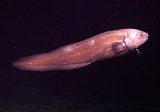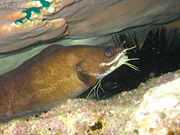
Ophidiidae
Encyclopedia
The cusk-eels family
(Ophidiidae) are a group of marine
bony fishes in the order
Ophidiiformes
. The scientific name is from Greek
ophis meaning "snake", and refers to their eel
-like appearance. However, they can be distinguished from true eel
s of the order Anguilliformes by the ventral fins, which are developed into a forked barbel
-like organ below the mouth in the cusk-eels; in the true eels by contrast they are never well-developed and usually missing entirely.
They are found in temperate and tropical oceans throughout the world. They live close to the sea bottom, at below 2000 metres (6,561.7 ft) depth. One species, Abyssobrotula galatheae
, was recorded at the bottom of the Puerto Rico trench
, making it the deepest recorded fish at 8370 metres (27,460.6 ft).
The largest species, Lamprogrammus shcherbachevi, grows up to 2 metres (6.6 ft) in length, but most species are shorter than a metre. Unlike their close relatives, the viviparous brotulas of the Bythitidae, they are egg-laying, and the larvae live amongst the plankton
, relatively close to the surface.
A few species are fished commercially, most notably the Pink Cusk-eel
, Genypterus blacodes.
 Subfamily Brotulinae
Subfamily Brotulinae
Subfamily Brotulotaenilinae




 Subfamily Neobythitinae
Subfamily Neobythitinae
 Subfamily Ophidiinae
Subfamily Ophidiinae
Family (biology)
In biological classification, family is* a taxonomic rank. Other well-known ranks are life, domain, kingdom, phylum, class, order, genus, and species, with family fitting between order and genus. As for the other well-known ranks, there is the option of an immediately lower rank, indicated by the...
(Ophidiidae) are a group of marine
Marine (ocean)
Marine is an umbrella term. As an adjective it is usually applicable to things relating to the sea or ocean, such as marine biology, marine ecology and marine geology...
bony fishes in the order
Order (biology)
In scientific classification used in biology, the order is# a taxonomic rank used in the classification of organisms. Other well-known ranks are life, domain, kingdom, phylum, class, family, genus, and species, with order fitting in between class and family...
Ophidiiformes
Ophidiiformes
Ophidiiformes is an order of ray-finned fish that includes the cusk eels , pearlfishes , brotulas , and others....
. The scientific name is from Greek
Greek language
Greek is an independent branch of the Indo-European family of languages. Native to the southern Balkans, it has the longest documented history of any Indo-European language, spanning 34 centuries of written records. Its writing system has been the Greek alphabet for the majority of its history;...
ophis meaning "snake", and refers to their eel
Eel
Eels are an order of fish, which consists of four suborders, 20 families, 111 genera and approximately 800 species. Most eels are predators...
-like appearance. However, they can be distinguished from true eel
Eel
Eels are an order of fish, which consists of four suborders, 20 families, 111 genera and approximately 800 species. Most eels are predators...
s of the order Anguilliformes by the ventral fins, which are developed into a forked barbel
Barbel (anatomy)
A barbel on a fish is a slender, whiskerlike tactile organ near the mouth. Fish that have barbels include the catfish, the carp, the goatfish, sturgeon, the zebrafish and some species of shark...
-like organ below the mouth in the cusk-eels; in the true eels by contrast they are never well-developed and usually missing entirely.
They are found in temperate and tropical oceans throughout the world. They live close to the sea bottom, at below 2000 metres (6,561.7 ft) depth. One species, Abyssobrotula galatheae
Abyssobrotula galatheae
Abyssobrotula galatheae is a species of cusk eel in the family Ophidiidae, and the only species in its genus. It is the deepest-living fish known; one specimen, trawled from a depth of 8,370 m in the Puerto Rico Trench in 1970, holds the record for the deepest fish ever captured...
, was recorded at the bottom of the Puerto Rico trench
Puerto Rico Trench
The Puerto Rico Trench is an oceanic trench located on the boundary between the Caribbean Sea and the Atlantic Ocean. The trench is associated with a complex transition between the subduction zone to the south along the Lesser Antilles island arc and the major transform fault zone or plate boundary...
, making it the deepest recorded fish at 8370 metres (27,460.6 ft).
The largest species, Lamprogrammus shcherbachevi, grows up to 2 metres (6.6 ft) in length, but most species are shorter than a metre. Unlike their close relatives, the viviparous brotulas of the Bythitidae, they are egg-laying, and the larvae live amongst the plankton
Plankton
Plankton are any drifting organisms that inhabit the pelagic zone of oceans, seas, or bodies of fresh water. That is, plankton are defined by their ecological niche rather than phylogenetic or taxonomic classification...
, relatively close to the surface.
A few species are fished commercially, most notably the Pink Cusk-eel
Pink cusk-eel
The pink cusk-eel, Genypterus blacodes, is a cusk eel of the genus Genypterus, found in southern Australia, Chile, Brazil, South Africa and around New Zealand except the east coast of Northland, in depths of a few metres to 1000 metres...
, Genypterus blacodes.
Genera
The cusk-eel family contains about 240 species, grouped into 50 genera:
- Genus BrotulaBrotulaBrotulas are a family, Bythitidae, of ophidiiform fishes, also known as viviparous brotulas as they bear live young. They are found in tropical and subtropical waters throughout the world...
– typical brotulas (5 species)
Subfamily Brotulotaenilinae
- Genus Brotulotaenia (4 species)





- Genus Abyssobrotula (1 species)
- Genus Acanthonus Günther, 1878 – Bony-eared Assfish (1 species)
- Genus Alcockia (1 species)
- Genus Apagesoma (3 species)
- Genus Barathrites ZugmayerErich ZugmayerErich Johann Georg Zugmayer was an Austrian zoologist and ichthyologist-Species described by Zugmayer:* Benthalbella infans Zugmayer, 1911* Cetostoma regani Zugmayer, 1914...
, 1911 (2 species) - Genus Barathrodemus Goode & Bean, 1883 (2 species)
- Genus Bassogigas Goode & Bean, 1896 (2 species)
- Genus Bassozetus Gill, 1883 – Typical assfishes (13 species)
- Genus Bathyonus (3 species)
- Genus Benthocometes (1 species)
- Genus Dannevigia – Australian Tusk (1 species)
- Genus Dicrolene Goode & Bean, 1883 (15 species)
- Genus Enchelybrotula (2 species)
- Genus Epetriodus – Needletooth Cusk (1 species)
- Genus Eretmichthys Garman, 1899 (1 species)
- Genus Glyptophidium (7 species)
- Genus Holcomycteronus Garman, 1899 (6 species)
- Genus Homostolus – Filament Cusk (1 species)
- Genus Hoplobrotula (3 species)
- Genus Hypopleuron – Whiptail Cusk (1 species)
- Genus Lamprogrammus Alcock, 1891 (5 species)
- Genus Leptobrotula (1 species)
- Genus Leucicorus (2 species)
- Genus Luciobrotula Smith & Radcliffe, 1913 (4 species)
- Genus Mastigopterus (1 species)
- Genus Monomitopus Alcock, 1890 (14 species)
- Genus Neobythites Goode & Bean, 1885 (50 species)
- Genus Neobythitoides (1 species)
- Genus Penopus Goode & Bean, 1896 (1 species)
- Genus Petrotyx (2 species)
- Genus Porogadus Goode & Bean, 1885 (13 species)
- Genus Pycnocraspedum (5 species)
- Genus Selachophidium – Gunther's Cusk-eel (1 species)
- Genus Sirembo (3 species)
- Genus Spectrunculus – (2 species)
- Genus Spottobrotula (2 species)
- Genus Tauredophidium (1 species)
- Genus Typhlonus (1 species)
- Genus Ventichthys – East-Pacific Ventbrotula (1 species)
- Genus Xyelacyba Cohen, 1961 – Gargoyle Cusk (1 species)

- Genus Cherublemma – Black Brotula (1 species)
- Genus Chilara – Spotted Cusk-eel (1 species)
- Genus Lepophidium Gill, 1895 (13 species)
- Genus Genypterus (6 species)
- Genus OphidionOphidionOphidion may refer to:* Ophidion , a genus of orchids* Ophidion , a genus of cusk eels...
(27 species) - Genus Otophidium (4 species)
- Genus Parophidion (2 species)
- Genus Raneya – Banded Cusk-eel (1 species)

